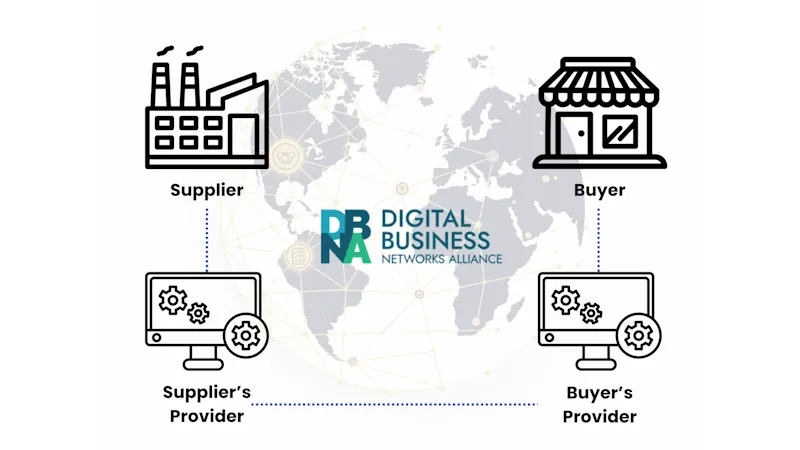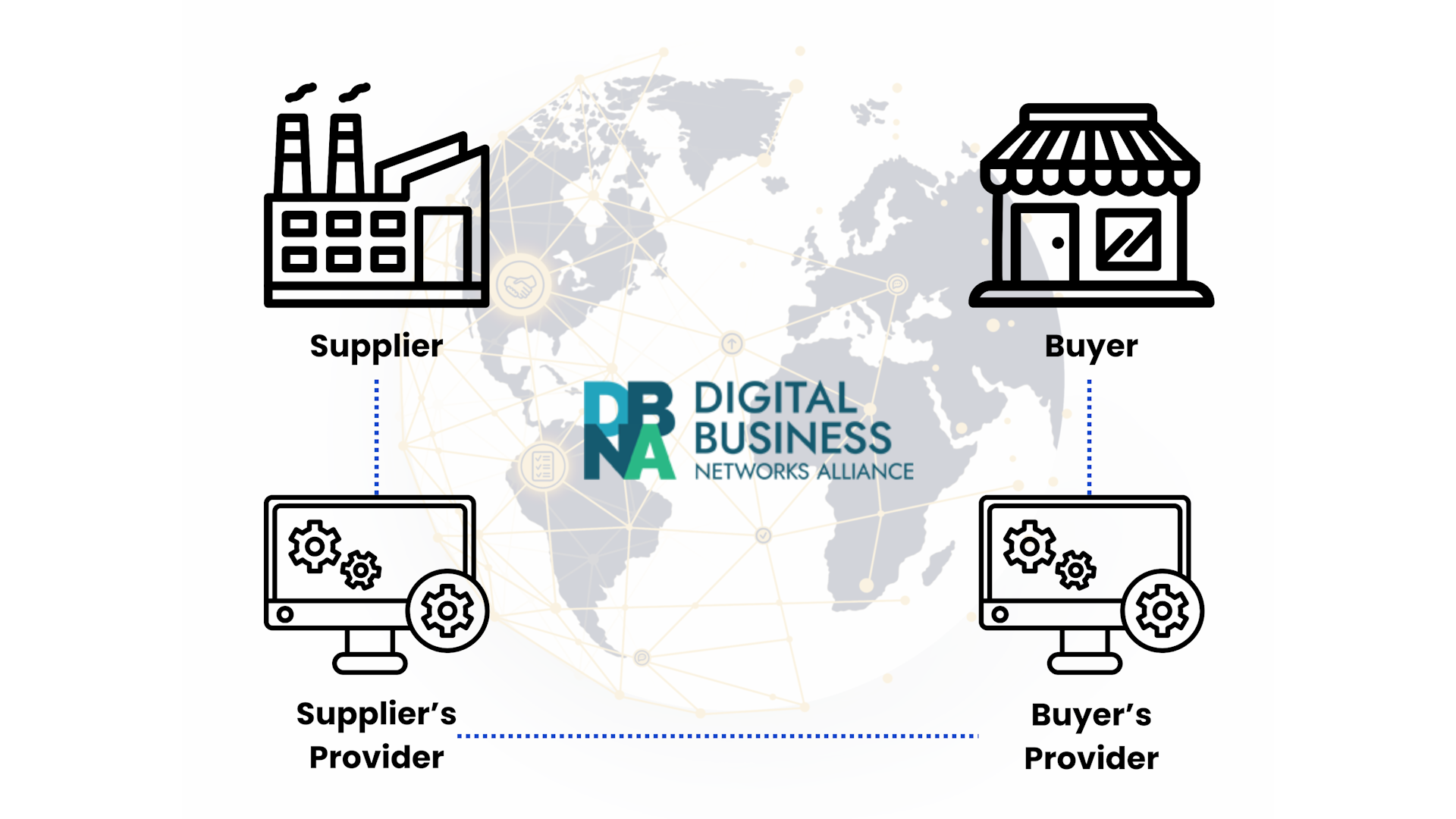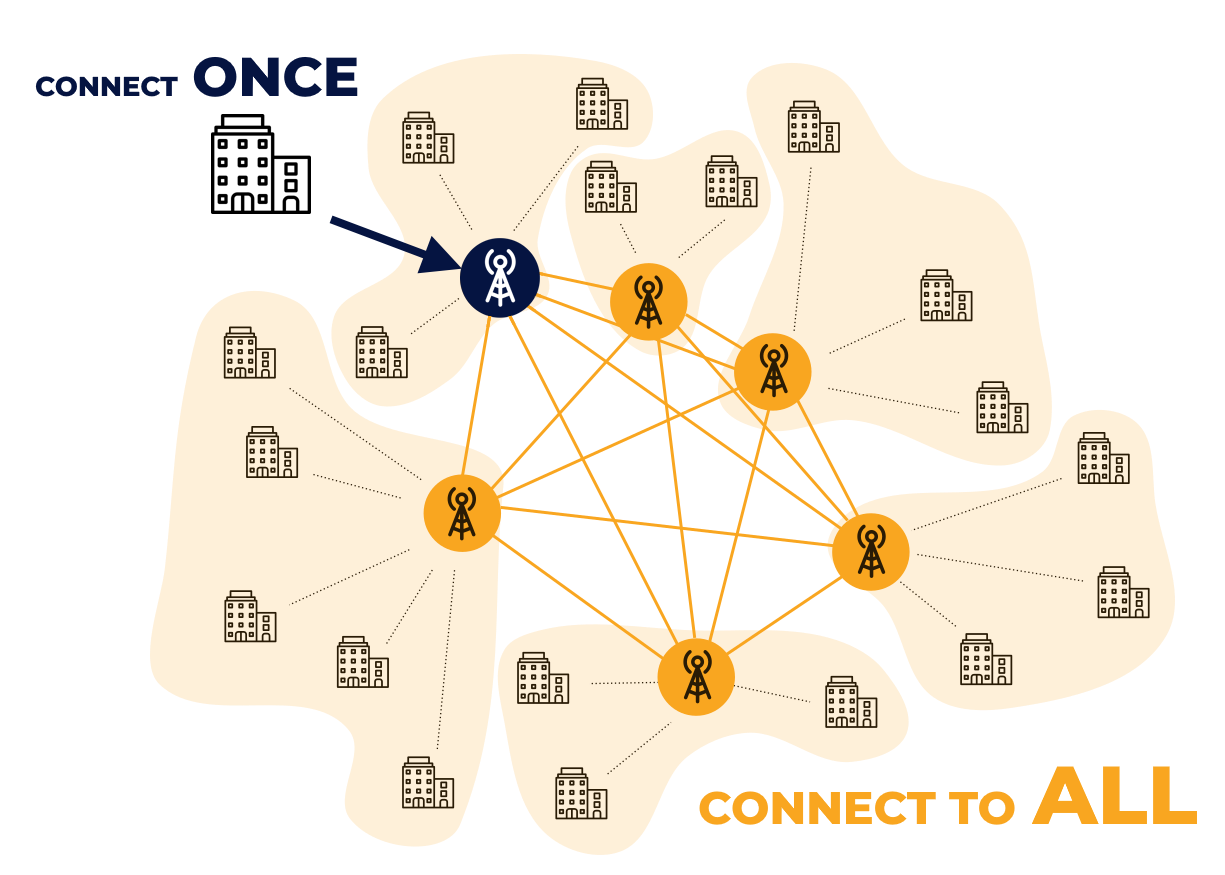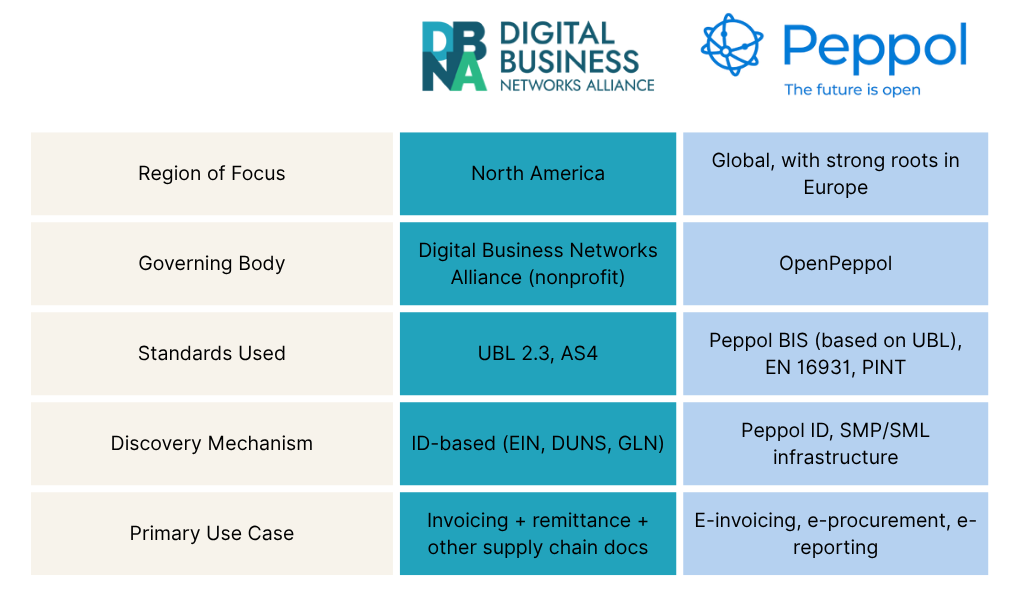DBNAlliance Network Overview
Summary
The DBNAlliance network is a decentralized business network that enables secure and standardized electronic document exchange – and more specifically invoices – between companies through its “Connect Once, Connect to All” approach.
The DBNAlliance network shares many concepts and structures with Peppol. This article highlights the shared benefits and synergy, and also mentions some of the different choices made in the creation of DBNAlliance network.
Four-Corner, Standardized Model
As its core architecture, DBNAlliance uses a four-corner model like Peppol, meaning the documents are received through an Access Point service provider that connects the network to the users. The communication protocols on the network are AS2/AS4. Users can request documents and generate status responses with the system as well.
- Corner 1: Document Sender (e.g., supplier)
- Corner 2: Sender’s Access Point (service provider)
- Corner 3: Receiver’s Access Point
- Corner 4: Document Receiver (e.g., buyer)
Key Benefits
Four-corner decentralized networks like Peppol and DBNAlliance offer a range of benefits that make it easy to adopt and integrate into existing business operations.
They connect seamlessly with current operating models and accounting systems, reducing the need for costly or time-consuming changes. Designed to be industry-agnostic, those networks can be used across a wide variety of sectors, making them highly versatile.
Built on open, non-proprietary standards, decentralized networks ensure smooth interoperability across platforms. They are designed to integrate with any existing ERP, accounting software, or payment system, regardless of vendor. This system-agnostic approach means businesses don’t need to overhaul their infrastructure or commit to a specific software provider.
Four-corner networks also support interoperability, and while adapting to network-specific BIS (Business Interoperability Specifications) document formats can require more effort, this standardization plays an important role in promoting common practices and formats across a wide range of jurisdictions. DBNAlliance takes a slightly different approach from Peppol by placing more emphasis on data mapping flexibility and workflow adaptability, which can be helpful in regions like the U.S., where business practices tend to be more decentralized and varied.
Finally, the DBNAlliance network also supports all types of electronic payments, providing the flexibility organizations need to manage their financial transactions efficiently. Hence, it fits naturally into both accounts payable and accounts receivable workflows, enabling companies to enhance their processes without disruption.
The U.S. Market Context
Electronic invoicing is rapidly being adopted as a secure and convenient method of exchanging B2B and B2C invoices globally.
Unlike many regions where e-invoicing has been driven by government mandates or tax compliance, the U.S. market has traditionally placed far more emphasis on payments than on invoices. The payments industry, backed by a developed banking sector and innovations in card networks, ACH, and real-time payments, has seen rapid growth and standardization.
In contrast, invoicing remained fragmented, with little regulatory pressure to unify formats or processes.This gap created a clear need for a network tailored to the U.S. business landscape.
DBNAlliance was developed with this context in mind: to bring interoperability and automation to invoicing without forcing U.S. companies to abandon familiar systems or identifiers.
The Business Payments Coalition (BPC) E-invoice Exchange Market Pilot members, in partnership with the Federal Reserve, launched this standardized e-invoicing system nationwide.
What is the DBNAlliance?
The Digital Business Network Alliance (DBNAlliance) is a nonprofit initiative designed to modernize how businesses exchange electronic documents across the U.S. and Canada, like its equivalent the OpenPeppol association.
Built on open, non-proprietary standards, the DBNAlliance promotes secure, efficient, and interoperable document delivery between companies, regardless of the platforms or service providers they use. The DBNAlliance operates a standards-based electronic delivery network that connects suppliers, buyers, and service providers along the “Connect once, connect to all” principle.
By establishing a shared framework, it enables the exchange of key business documents like e-invoices, e-remittance, and other supply chain documents without the need for custom integrations or manual interventions.
Differences between Peppol & DBNAlliance
Both the DBNAlliance and Peppol networks share a common concept, technical architecture, overall philosophy, making them largely identical on a structural level. To many, DBNAlliance may simply appear as “another Peppol network.”
However, let’s take a closer look at the differences in detail between them, and how they compare in practice.
Region of focus
DBNAlliance is tailored for North America, aligning closely with U.S. and Canadian business practices. Peppol, in contrast, is a global network with deep roots in Europe and strong adoption across the EU, Australia, and parts of Asia.
Governing Body
DBNAlliance is managed by the Digital Business Networks Alliance, a U.S.-based nonprofit focused on secure and efficient digital transactions. Peppol is overseen by OpenPeppol, a European nonprofit organization that sets global e-procurement standards.
Standards Used
Discovery Mechanisms
DBNAlliance uses UBL 2.3 and AS4 for message formatting and secure exchange. Peppol also builds on UBL, and follows Peppol BIS, EN 16931, and PINT standards.
DBNAlliance supports U.S. business identifiers such as EIN, DUNS, and GLN. The network also uses a Service Metadata Locator (SML) to point to each organization’s Service Metadata Publisher (SMP), which provides details like document types, supported processes, AS4 endpoints, and security certificates.
Peppol, on the other hand, uses Peppol Participant IDs based on the international ISO 6523 standard, which supports a wide range of global participants and identifier schemes. Like Peppol, DBNAlliance also uses SML and SMP services for participant discovery and metadata management. However, DBNAlliance’s U.S.-centric approach sets it apart from Peppol’s governance under OpenPeppol and focus on international interoperability.
Primary Use Case
DBNAlliance covers a broader range of use cases, including invoicing, remittance, and general electronic documents. Peppol is primarily used for e-invoicing, e-procurement, and regulatory reporting, especially in public sector transactions.
Highlights of the DBNAlliance Approach
- Aligned with U.S. Business Practices: Tailored to North American legal, tax, and business environments.
- Single Connection, Broad Reach: Businesses only need to connect once to reach any other participant, simplifying onboarding.
- Supports Full B2B Payment Lifecycle: Goes beyond invoicing to include remittance data and potential for future expansion into more document types.
- Non-Disruptive Onboarding: Works with existing tools and processes – no need for proprietary portals or vendor lock-in.
- Secure and Scalable: Built with compliance and data protection in mind, using modern protocols and federated governance.
The Invoicing Hub Word
Decentralized networks are shaping the future of
e-invoicing
Although the Peppol network is widely adopted in Europe and Asia, its presence along with broader e-invoicing adoption remains limited in North America, particularly in the United States, despite the region representing one of the largest shares of global economic activity.
One of the main reasons e-invoicing adoption is slower in the U.S. is the absence of a federal tax system. In Europe, governments mandate e-invoicing to fight VAT fraud and improve tax collection. Since the U.S. doesn’t have a similar tax, there’s less motivation for a nationwide mandate. Additionally, the U.S. has a highly fragmented system with lots of state and local tax jurisdictions, making it harder to implement a unified approach.
This highlights why in the United States payment processing is more important, as businesses ultimately prioritize cash flow and receiving actual funds. For this reason, the DBNAlliance network was launched by the Business Payments Coalition, focusing on streamlining payment and promote the adoption of e-invoicing.
Ultimately, e-invoicing is gaining traction thanks to the “Connect once, connect to all” approach used by decentralized networks like Peppol and DBNAlliance. Increasingly, companies are adopting these networks to leverage their benefits and enhance operational efficiency.
We can only hope that seamless bridges are established between these networks at some point, so they don’t become isolated e-invoicing silos, but instead contribute to building a unified and integrated ecosystem.
Additional Resources
Nonprofit ensuring the governance of the DBNA network
Automated service to validate UBL 2.3 documents
SML/SMP lookup discovery tool to help users find DBNA network participants
Service providers offering interoperability via the DBNA network
Get your Project Implemented
Gold Sponsor
Billit is a certified Peppol Access Point, EU certified open banking (AISP) provider enabling secure e-invoicing across Europe and beyond. The platform currently supports 120,000 users (Q1 2025) who process more than 2 million invoices monthly. It also offers a free portal for accountants, enhancing collaboration with clients.
With offices in Ghent, Brussels, Sint-Niklaas, and Hamburg, Billit is a trusted partner in digital transformation.
Latest News
Veri*Factu faces another delay, now pushed to 2027
Webinar – The Global Shift to e-Invoicing
E-invoicing in Belgium will start with a 3-month grace period
Another delay for mandatory e-signature on PDFs in Portugal
Understanding the e-invoicing clearance model in Israel
The Invoicing Hub
experts can help you
Strategy, Guidance, Training, …









